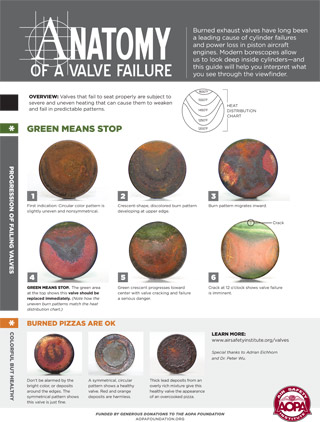P&E Ownership: Anatomy of a valve failure
ASI poster for aircraft engine shops
 New, digital borescopes allow aircraft mechanics to thoroughly inspect the inner workings of piston engines without removing cylinders, but who knows how to interpret the images they see?
New, digital borescopes allow aircraft mechanics to thoroughly inspect the inner workings of piston engines without removing cylinders, but who knows how to interpret the images they see?
Adrian Eichhorn, a pilot and mechanic who pioneered the use of medical imaging technology for aircraft engines, has his own method for evaluating failure-prone exhaust valves, and he’s sharing it with the help of the AOPA Foundation’s Air Safety Institute (ASI). Eichhorn and ASI have created a poster, “Anatomy of a Valve Failure,” that shows an exhaust valve as it approaches a potentially catastrophic failure.
With financial support from pilots and aircraft owners to the AOPA Foundation, ASI designed and printed the posters and is distributing them free to aircraft engine shops and maintenance schools throughout North America.
“Both Lycoming and Continental valves share certain similarities in how they are designed, how they work, and what they look like before they fail,” Eichhorn said. “I’ve examined hundreds of valves using medical technology, and the patterns are easy to recognize. You’ve just got to know what to look for.”
Eichhorn said he’s seen no correlation between valve wear and whether an engine is operated rich or lean of peak EGTs. The keys to valve longevity, he said, are for pilots to keep cylinder head temperatures within normal limits, and for mechanics to periodically check for proper valve seating.
Burn patterns are subtle at first, with slight discoloration near the edges. The patterns become more pronounced and the scorched portions of the valves develop a green hue. “Green means stop on exhaust valves,” Eichhorn said. “If a portion turns green, it’s time to replace the valve. There’s no reason to go beyond that point.”
If allowed to progress, the green portion will reach deeper toward the center of the valve. In advanced cases, two green portions will appear on opposite edges of a valve as hot gas from the combustion chamber reaches around it. In the final stage before a potentially disastrous failure, cracks can appear in the valves and the edges turn a steely color.
“What you’re seeing is the valve eroding,” Eichhorn said. “The erosion prevents the valve from seating properly, and that accelerates its demise.”AOPA
Email [email protected]


